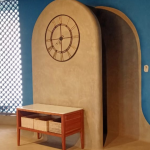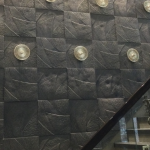What’s the Right Finish for Exterior Wood Cladding: A Designer’s Take
There’s an undeniable allure to a home wrapped in exterior wood cladding. It speaks of natural beauty, timeless elegance, and a deep connection to the environment. Whether you’re a new homeowner dreaming of your ideal facade, or an interior and exterior designer curating a distinctive project, choosing wood for your exterior is a decision that promises character and warmth. But once you’ve decided on this beautiful material, a crucial question emerges: What’s the right finish?
This isn’t just about aesthetics; it’s about longevity, maintenance, and how your home will gracefully age. The finish you choose for your exterior wood cladding acts as its shield, protecting it from the elements while profoundly impacting its visual story. Let’s dive into the world of wood finishes, offering a designer’s perspective to help you make an informed choice that blends beauty with practical resilience.
Understanding the Basics
Before exploring specific options, it’s important to understand why finishing your exterior wood cladding is so vital. Wood, as a natural material, is susceptible to various environmental factors:
- UV Radiation: The sun’s rays can break down wood fibers, leading to discoloration (graying) and surface deterioration.
- Moisture: Rain, snow, and humidity can cause wood to swell, crack, and become a breeding ground for mold, mildew, and rot.
- Pests: Insects can bore into untreated wood, compromising its structural integrity.
A proper finish acts as a barrier against these threats, preserving the wood’s beauty and extending its lifespan. It also plays a significant role in defining the final look and feel of your home’s exterior, from a rugged, natural appeal to a sleek, contemporary sheen.
The Spectrum of Choices
When it comes to finishing wood cladding, you generally have a few key categories, each with distinct advantages and visual outcomes.
1. The Natural Evolution: No Finish (or Penetrating Oil)
For some, the ultimate expression of wood cladding is to let it be. Unfinished wood, particularly durable species like cedar or redwood, will naturally weather and oxidize over time, developing a beautiful, silvery-gray patina. This “pre-aged” look is often sought after for rustic, coastal, or contemporary designs aiming for a harmonious blend with nature.
- Aesthetic: Earthy, authentic, blends seamlessly with natural landscapes. The graying process is part of its charm.
- Maintenance: Minimal initial maintenance. However, while some woods are naturally resistant, continuous exposure without protection can lead to surface deterioration. Annual cleaning is still recommended to prevent mildew.
- Durability: Good for naturally durable wood species. Less protection against moisture and UV than other finishes.
Designer’s Take: This option works best when you embrace the natural weathering process fully and select highly durable, rot-resistant wood species. It creates a serene, understated elegance. If you want to slow down the graying process but still maintain a natural look, a clear penetrating oil can offer some UV protection without forming a surface film.
2. Enhancing the Grain: Transparent & Semi-Transparent Stains
If you love the natural grain and color of your wood cladding but want to protect it and add a touch of color, transparent and semi-transparent stains are excellent choices.
- Transparent Stains: Offer UV protection while allowing the natural color and grain of the wood to show through completely. They come in clear or very light tints that subtly enhance the wood’s natural tone.
- Semi-Transparent Stains: Contain more pigment than transparent stains, adding a hint of color while still allowing most of the wood grain to be visible. They provide better UV protection and durability than transparent options.
- Aesthetic: Highlights the natural beauty of the wood, adding a subtle warmth or specific hue.
- Maintenance: Requires reapplication every 2-5 years, depending on sun exposure and product quality. Easy to re-coat as they don’t typically peel.
- Durability: Good protection against UV rays and moisture.
Designer’s Take: These are perfect for showcasing the unique patterns of decorative wood panels for walls on your exterior. They allow the wood’s inherent character to shine through, creating a sophisticated and natural facade. Consider the specific undertones of your wood and how they will interact with the stain color.
3. Bold & Protective: Solid Stains & Paints
For maximum protection and a distinct color statement, solid stains or exterior paints are your go-to.
- Solid Stains: Completely opaque, obscuring the wood grain but allowing the texture to remain. They penetrate the wood slightly, offering excellent durability and resistance to peeling.
- Paints: Form a protective film on the surface of the wood. They offer the widest range of colors and a smooth, uniform appearance.
- Aesthetic: Transforms the exterior wood cladding into a colored canvas. Solid stains maintain some wood texture, while paints offer a slick, uniform finish.
- Maintenance: Solid stains generally last 5-10 years, offering good longevity with minimal peeling. Paints can last 7-10+ years but are more prone to peeling or chipping over time, requiring scraping before reapplication.
- Durability: Offer the highest level of protection against UV and moisture, completely sealing the wood.
Designer’s Take: If you’re looking to create a striking contrast or integrate your home with a specific color scheme, solid stains or paints provide the ultimate flexibility. They can make your wood wall cladding pop, transforming it into a contemporary feature. Remember that dark colors absorb more heat, which can affect wood movement.
Considering Your Climate and Lifestyle
Beyond aesthetics, your geographic location and personal willingness for maintenance are critical factors in choosing the right finish for your wood cladding.
- Harsh Climates: If your home experiences extreme temperatures, heavy rainfall, or intense sunlight, you’ll need a finish with superior UV and moisture protection, and one that is flexible enough to accommodate wood’s natural expansion and contraction. Solid stains and high-quality exterior paints often perform best here.
- Coastal Environments: Salt spray can be corrosive. Look for finishes specifically designed for marine environments or those known for their excellent resistance to salt and moisture.
- Maintenance Commitment: Be honest with yourself about how much upkeep you’re willing to do. Some finishes, like transparent stains, require more frequent reapplication than opaque options. Natural weathering, while low on active reapplication, requires acceptance of wood’s changing appearance.
While this discussion has focused on exterior wood cladding, many of these principles apply to interior applications as well, particularly for high-traffic areas or spaces prone to moisture like bathrooms. For interior wooden wall panels and decorative wood panels for walls, the focus shifts more towards aesthetic preferences, tactile feel, and ease of cleaning, with less emphasis on extreme weather protection. Clear lacquers, varnishes, and even natural waxes are popular interior choices, preserving the wood’s beauty while offering varying levels of durability.
The Designer’s Recommendation: Balance and Vision
Ultimately, the “right” finish for your exterior wood cladding is a blend of your desired aesthetic, the specific wood species you’ve chosen, your local climate, and your commitment to long-term maintenance.
Start with your vision: Do you dream of a home that will age gracefully, becoming one with its natural surroundings? Or a structure that stands out with a bold, consistent color? Then, consider the practicalities. Speak with suppliers, gather samples, and visualize how the finish will look not just today, but years down the line. By making an informed decision, you ensure that your wood cladding remains a stunning feature, a testament to both nature’s beauty and thoughtful design, for decades to come.












